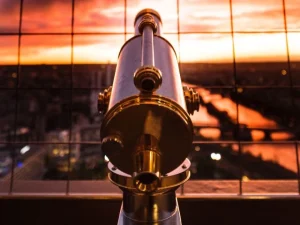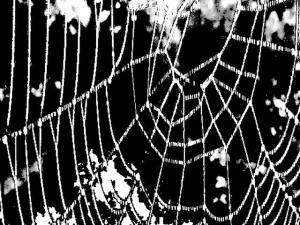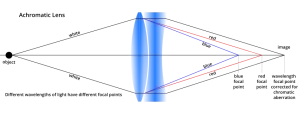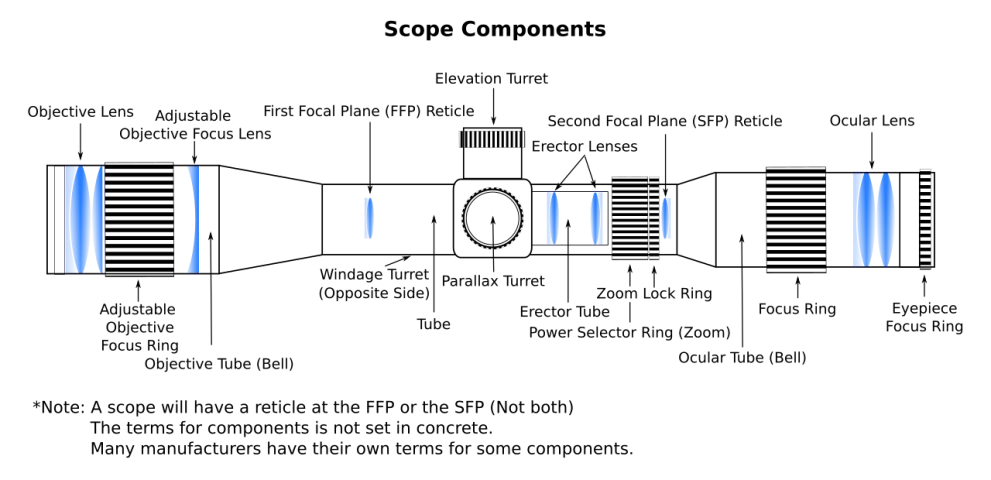

Scopes & Optics
Scopes or Telescopic sight is an optical sighting device that is designed to enhance the view of a target at range. The are many useful optic devices available today with a variety of uses.
Table of Contents
Scopes or Telescopic sight is an optical sighting device that is based on the refraction of light. Ideal for long-range shooting. The magnification of the optics make it easy to pick and line up your target. The reticle gives you accurate aiming points in any lighting condition, making this device one of the most popular sights on rifles today!
Most common today is the ability to combine the optics with electronics to enable the scope to be useful in low light and night conditions.
History of the Scope
1608
Refracting Telescope
 The first known practical refracting telescope was invented in the Netherlands in 1608, and it was used for both terrestrial and astronomical observations.
The first known practical refracting telescope was invented in the Netherlands in 1608, and it was used for both terrestrial and astronomical observations.
Late 1630's
A spiders web

While experimenting with lenses, William Gascoigne, an English amateur astronomer, discovered that a spider’s web spun at a precise point between two lenses in his telescope allowed him to align the instrument with greater precision.
1729
Achromatic Lens
 While studying the human eye, Chester Moore Hall, an English mathematician, discovered that an achromatic lens was a possibility. He found that by combining flint glass and crown glass he constructed the first achromatic lens.
While studying the human eye, Chester Moore Hall, an English mathematician, discovered that an achromatic lens was a possibility. He found that by combining flint glass and crown glass he constructed the first achromatic lens.
1776
A Telescope Mounted on a Firearm
 Experiments by a number of people were conducted on how to mount a telescope to a rifle.
Experiments by a number of people were conducted on how to mount a telescope to a rifle.
1835-1840
The first documented telescopic sight
 American gunsmith Morgan James with direction from John R. Chapman produced the Chapman-James telescopic sight. The sturdy construction of these sights meant the sighting remained true even after a number of shots. It is therefore widely regarded as the first practical telescopic sight.
American gunsmith Morgan James with direction from John R. Chapman produced the Chapman-James telescopic sight. The sturdy construction of these sights meant the sighting remained true even after a number of shots. It is therefore widely regarded as the first practical telescopic sight.
1855
Achromatic Lenses

William Malcolm, an American optician produced his own sight using Achromatic lenses and improved elevation and windage adjustments.
1880
Refracting Telescopics

An Austrian, August Fiedler produced one of the early versions of refracting telescopic sights that was actually practical to use.
Classification of Scopes
Scopes are classified as:
“Power or Optical Magnification” X “Objective Lens Diameter”
For example a scope described as:
“6×40” = a magnification of 6× and an Objective Lens of 40mm.
“6-10×50” = a variable magnification of 6× to 10× and an Objective Lens of 50mm.
Binoculars, also known as field glasses or binocular telescopes, are instruments used to magnify distant objects by using two telescopes mounted side-by-side and aligned to point in the same direction. They allow the viewer to see objects that are far away as if they were closer, making them a useful tool for a variety of activities such as birdwatching, hunting, boating, and watching sporting events.
Night vision lets people to see in low light conditions, or even complete darkness by using special equipment to amplify ambient light. It can be moonlight, starlight or even the glow of a firefly and convert it into an image that is visible to the naked eye. There are many types of night vision equipment for goggles, binoculars, cameras and scopes.
Thermal vision lets people to see in no light conditions, complete darkness by using special equipment to amplify ambient light. It can be used through fog, smoke dust or scrub. There are many classes of thermal vision equipment for goggles, binoculars, cameras and scopes.
Yet another class of optic is the red dot sight. A sight that displays an illuminated aiming point (reticle) for the operator that is superimposed on the field view. This places the target and the reticle virtually on the same optical plane, facilitating fast acquisition.
Photo Credits: Kyler Boone | Unsplash
